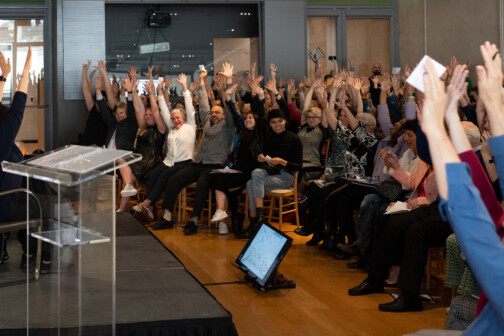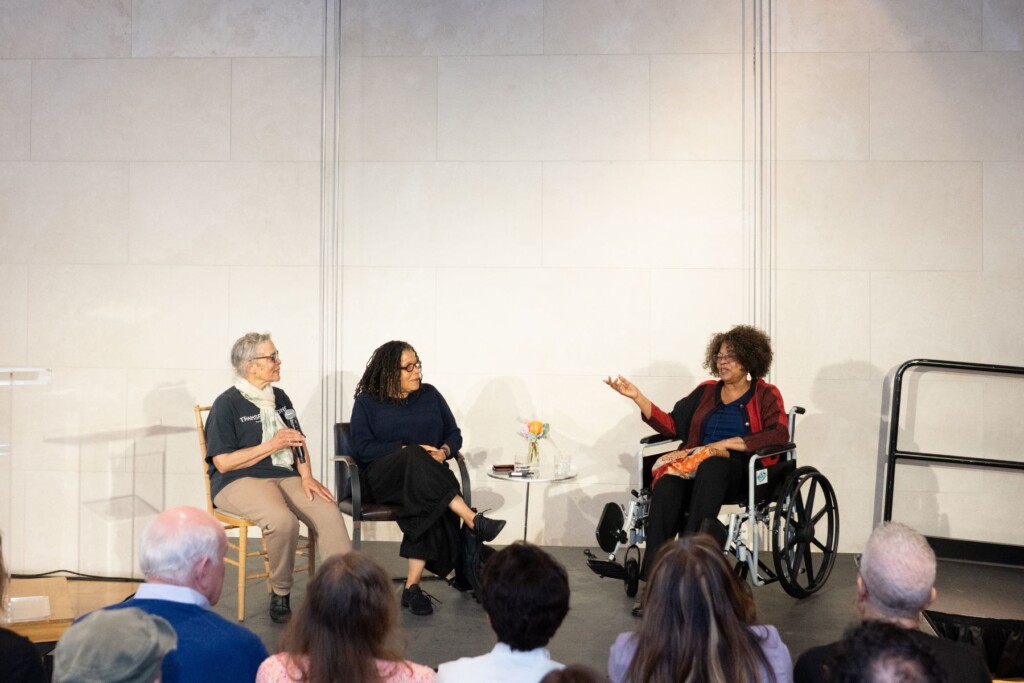Nearly halfway through her recent artist talk, 2023 Nasher Prize Laureate Senga Nengudi looked out at the audience and said, “You have two people up here who share utter boredom on a stage.” She was referring to Linda Goode Bryant, a longtime collaborator, whom she had chosen to be in conversation with that afternoon. “We just think artist talks are so boring. You all must be bored shitless.”
There are lots of words that could be used to describe Nengudi’s 90-minute discussion of her life, work, collaborators (and seemingly anything else that popped into her head), but boring wouldn’t make the list. Ten minutes in, she asked the crowd of 100 or so artists, art lovers, academics, and a large group of Booker T. Washington High School dance students to stand up, stretch their hands, turn around, and “shake your booties.”
By minute 20, she had passed out a series of cards to the front row with words like “rub,” “laugh,” “cheer,” and “balance.” When they read their cards, audience members were asked to spontaneously join them in the prompt. Former Nasher Prize Laureate Nairy Baghramain stood up to “move differently,” later local artist Kaleta Doolin joined in for “sparkle.” At first, it was stiff and weird. Eventually, the entire room joined in the chorus for “cheer.”
If your only experience of Nengudi’s work is the small selection of pieces in “Works on View,” which can be found in the vestibule gallery space through April 30, you might wonder what earned her this prestigious international sculpture award, which comes with a stipend of $100,000. They are mostly photographs of previous works or “happenings.” But if you were in the room with her at any point throughout the weekend, it became easier to understand.

Since its inception in 2015, the Nasher Prize has been awarded to artists who are challenging the definition of sculpture. In 2017, it was awarded to the French artist Pierre Hugyhe, known for breaking down the boundaries between film, art, and material. Years ago, the Nasher had one of his fish tanks on display, which contained a giant hermit crab. In 2018, it was awarded to Chicago-based artist Theaster Gates, whose community-driven work can be experienced through the end of this month in “Afro Mingei” at the Nasher. It’s part art installation, part bar (try the matcha cocktail!), part event venue.
Meanwhile Nengudi, 79, blurs the boundaries between performance art and sculpture. In the 70s, she began collaborating with other artists like Goode Bryant and Maren Hassinger (who arrived straight from the airport to the talk and climbed on stage with her friends). They were radical and ahead of their time. By their very nature, they operated outside of the establishment, which at the time was very male and very White. They were making art under freeways and bringing dance into the gallery, tinkering with ritual and movement, adding in music and artifacts. They were sculpting space and experience, making meaning through interaction and repetition, and documenting along the way.
“I’m a firm believer in documentation,” Nengudi said. “We had to have a record that we exist, because in the larger realm, in the art realm, we did not exist.”
In her early career, Nengudi was bicoastal. She worked with JAM (Just Above Midtown) in New York, an avant garde space created by Goode Bryant to support African American artists. And she was part of the Studio Z collective, sometimes called the LA Rebellion, where she met longtime collaborators Hassinger and David Hammons.
This was in the aftermath of the 1965 Watts Rebellion, one of the biggest and most violent uprisings in Los Angeles history, the direct result of police brutality against two Black residents. Nengudi’s work, which is sometimes categorized as apolitical—perhaps merely because it is abstract—brushed up against this pivotal moment in California and US history. (She taught art at the Watts Tower Art Center in 1965.) And moving freely, occupying space, manipulating materials becomes political if the color of your skin poses a hazard for your life.
But Nengudi is a sculptor in a more traditional sense, as well. She uses her hands and tools to create objects that take up three-dimensional space in museums throughout the world. Her work can be found in the collections of the Tate London, Solomon R. Guggenheim in New York, and the Los Angeles County Museum of Art, and many others.
If you’re at the Museum of Modern Art in New York City, you can see a work from her most famous series “R.S.V.P.,” which Nengudi made after experiencing the way a female body changes through childbirth. She filled nylon pantyhose with varied amounts of sand, hanging them at various heights. They’re fleshly and bulbous, stretched thin in some parts, constrained tightly in others.
In “Works on View,” visitors can see one of Nengudi’s “Water Compositions,” in which she fills fragile, plastic bags with brightly dyed water. In its original iterations, visitors were encouraged to hold and touch the sacks, but this is no longer permitted due to the fragile nature of the materials, which might burst like a water balloon. (Sounds like way too much fun for a museum.)
Near the end of the artist talk, a brief thunderstorm could be seen through the windows sweeping through the sculpture garden. Nengudi paused and looked at her friend who had since joined her and Goode Bryant on the stage. “The way those leaves are falling right now. That’s a Maren piece,” Nengudi said, explaining that art is sometimes just about reframing a moment. “I often look at something and say: I claim you art.”
When we were leaving the space, I turned to my seatmate and said, perhaps a bit cynically, “Everyone in this room is going to spend the next 24 hours pointing at the things around them claiming them as art.”
Five minutes later, I ran into the local performance artist Erica Fellicella and the first thing that tumbled out of my mouth was: “That talk was the art, wasn’t it?” She just smiled wisely and nodded. I hadn’t seen her in months, so we hugged and talked about our lives, catching up on our love lives, work, and general health. In hindsight, maybe that was the art, too? I think Nengudi would tell me to claim it.
Author







